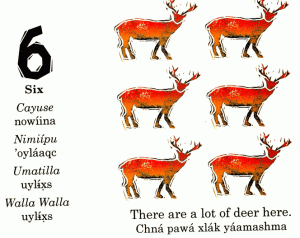 “There were once thirteen native language families in the region that is now Oregon: Alsea, Athabascan, Cayuse, Chinookan, Coosan, Kalapuyan, Klamath, Molala, Sahaptian, Salish, Siuslaw, Takelma, and Uto-Aztecan. Today only Paiute, Klamath, Wasco, and Sahaptian survive in the spoken form. “–Noel Rude, preface, My Counting Book, Tamástslikt Cultural Institute, 2002
“There were once thirteen native language families in the region that is now Oregon: Alsea, Athabascan, Cayuse, Chinookan, Coosan, Kalapuyan, Klamath, Molala, Sahaptian, Salish, Siuslaw, Takelma, and Uto-Aztecan. Today only Paiute, Klamath, Wasco, and Sahaptian survive in the spoken form. “–Noel Rude, preface, My Counting Book, Tamástslikt Cultural Institute, 2002
Have you taken in the Eastern Oregon Word Round-Up? If you heard of Wordstock in Portland, this is its east-side sibling, happening right here on the Umatilla Indian Reservation today and tomorrow.
Dr. Noel Rude brought half an index card with a few bullet points for his session, “Efforts to Create a Umatilla Language Dictionary.” Oregon is quite unusual for its rich diversity of aboriginal languages whereas from southern Oregon to Mexico City, the language would have been Uto-Aztecan–just the way the world is becoming dominated by English.
Dr. Rude asked, do you all enjoy grammar? to predictable moans and groans, even among an audience of writers and readers. When he worked at a sawmill, Dr. Rude would leave work saying he was ready to curl up with a beer and a good Arabic grammar. Linguists do enjoy grammar.
Who invents grammar? he asked. It’s children, the most brilliant systematizers. Children have the urge to regularize speech. That’s why a child would be prone to conjugate the word ‘go’ by saying, “Daddy go’d store.”
The Sahaptin hunter-gatherers developed massive noun declensions and almost infinite verb systems. Whereas English only has about four verb tenses in common usage because English adopted modifying auxiliaries. Why should a society without a written language develop such a massive grammar? This cannot be answered.
Dr. Rude asked, do you all know what is the native language of this territory where we are sitting today? The fact that we were sitting in Cayuse Hall was a hint. The last known speaker of the Cayuse language passed away before WWII. The Cayuse people knew themselves as ‘liksiyu’ and they later became known as “Weyíiletpuu”, a Nez Perce term. Cayuse may have been a distant cousin of Sahaptin, but not enough remains of the language to determine its origin. Dr. Rude wrote a paper suggesting that Cayuse could be related to Klamath. The anthropologist Melville Jacobs came to Cayuse country and begged the last few remaining speakers to allow him to document the Cayuse language. They refused for their own good reasons, so the language has not been documented beyond a vocabulary of about 300 words.
Why can’t a language be revitalized if it has only a vocabulary? Grammar is unconscious. We may build up a huge vocabulary but the grammar is an underlying construct that exists in our subconscious. If you don’t believe your knowledge of grammar is deep within your unconscious, then can you explain all the rules pertaining to the word ‘the.’
Revitalization can lead to the creolization of a language, pidgin such as Chinook jargon, the trade language developed from several tongues. Pidgin is the product when adults create grammar, he said.
An uproar arose when he asked the question, what is the most successfully revitalized language? Hebrew. Immediately audience members began to clamor, “it’s not the same language”… “They’re not speaking authentic Hebrew…” “The Hebrew of the Bible is like Chaucer’s English to modern English.” Just paraphrasing. People have strong feelings about language revitalization.
Of all the Indian languages, Dr. Rude concluded Navajo may be the only viable Indian language. At one time, Dr. Rude said, Navajo possessed a base of about 120,000 native speakers.
Dr. Rude’s late mother had a friend, a full-blood Cherokee who was also a fluent speaker. When his mother died, her friend was there. He asked her, “How is the language? How is the revitalization coming along?” She said, “Fine. It’s a massive attempt, but I can’t understand one word they are saying.”
As a longtime university lecturer, Dr. Rude was quite spellbinding. Yet after his session, I wondered, what about the dictionary?
